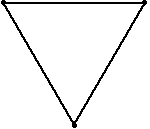
Remember
this one?
In this problem, the three bugs start at the corners of an equilateral triangle (with side length=10 inches).
Again, the bugs travel directly towards their neighbor (counter-clockwise). And, again, each bug homes in on its target, regardless of its target's motion. So, their paths will be curves spiraling toward the center of the triangle, where they will meet.
What distance will the bugs have covered by then, and how did you determine it?
In the 4-bugs problem, each bug was headed directly for his neighbor and his neighbor's motion had no effect, so that the total distance traveled was exactly the initial distance to his neighbor.
In this problem, the decrease in distance results not only from each bug's individual motion, but is assisted by the pursued neighbor's motion, which has a component toward the pursuer. Thus the pursuer (as each is, in turn) does not have to travel as far as the full distance to the pursuee.
If the speed of motion is taken as 1, a vector diagram will have a 30-60-90 triangle, with the hypotenuse being 1 and the leg representing the component of motion toward the pursuer being 1/2. (The component perpendicular to the pursuer's motion being (√3)/2, but that's beside the point.)
As a result, the pursuer is contributing a speed of 1, while the pursuee is contributing a speed of 1/2 in closing their gap. So each pursuer need go only 2/3 the full original distance to his neighbor (while the neighbor in effect reduces the distance by 1/3--a 2:1 ratio), or
six and two thirds inches.
|
|
Posted by Charlie
on 2004-01-22 14:54:39 |
 Remember this one?
Remember this one?


